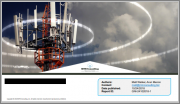
|
시장보고서
상품코드
1741559
미국 통신사의 설비 투자가 감소, AI 대기업이 주역으로 부상US Telco Capex Fading as AI Giants Take Center Stage |
||||||
미국은 여전히 세계 최대 시장이지만, 2024년 통신 설비투자는 8% 감소한 810억 달러로 떨어지고, 2025년 1분기 전망도 약화될 것으로 보입니다. 통신사들은 정책 불확실성, 인플레이션 우려, AI 버블 속에서 투자보다 수익화에 주력하고 있습니다.
본 보고서에서는 AT&T, Verizon, Charter, Comcast, T-Mobile(DT), Lumen, Frontier 등 주요 통신 사업자의 2025년 1분기 실적을 바탕으로 미국 통신 설비 투자에 대한 단기적 전망을 살펴봅니다. 현재 지출 패턴과 과거 예측과의 비교, 투자 결정에 영향을 미치는 주요 요인을 파악하고, 벤더에 미치는 영향, AI, 대규모 언어 모델(LLM), 데이터센터 등 신흥 분야 동향에 대해 분석합니다.
미국 시장은 2024년 말 기준 통신 설비투자가 805억 달러, 수익이 5,052억 달러로 각각 세계 전체 산업의 27%와 28%를 차지할 것으로 예측됩니다. 미국의 설비투자와 수익의 비율, 즉 자본집약도는 2022년부터 2023년까지 17-18% 범위로 과거 수준을 크게 상회할 것으로 예측됩니다. 이 비율은 2024년에 들어서면서 완만해져 연간 자본집약도는 15.9%를 기록했으며, 2025년 1분기 실적 발표 및 기타 데이터에 따르면 이 비율은 더 낮아질 것으로 예측됩니다. 미국 통신사들은 지금까지의 투자를 수익으로 전환하는 데 중점을 두고 자본을 절약하고 비용을 절감하는 데 우선순위를 두고 있습니다. 경제와 정책의 불확실성은 여전히 높으며, 대통령의 무역 비상사태로 인해 인플레이션과 경기 침체에 대한 우려가 커지고 있습니다.
통신사들은 설비투자를 아끼는 반면, 데이터센터 시장의 대규모 투자 거품은 아이러니하게도 통신사들은 투자자들의 관심을 끌기 위해 고군분투하고 있습니다. 통신사들은 비슷한 투자자들의 관심을 끌기 위해 고군분투하고 있습니다. 그럼에도 불구하고 미국에서 AI로 이익을 얻을 수 있는 다른 길을 모색하고 있습니다. 생성형 AI의 물결에 잘 올라타고 있지는 않지만, AI 기술을 활용해 업무 효율을 높이기 위한 노력을 기울이고 있습니다.
향후 몇 분기 동안 미국 통신사업자의 설비투자는 계속 억제될 것으로 보입니다. 경제 성장 둔화는 통신 수익에 타격을 줄 것입니다. 정부 부채 증가와 관세의 도입은 인플레이션을 가속화할 것입니다. 미국을 방문하는 해외 방문객의 감소와 해외 투자 감소는 모두 수요 감소로 이어질 수 있습니다. 또한, 관세는 네트워크 구축에 사용되는 특정 부품의 부족과 가격 상승을 유발할 수 있습니다. 인접 분야인 데이터센터에 대한 투자가 급증하면서 통신사들은 자체 인력 확보 및 유지가 어려워지고 인건비도 상승할 것입니다. 그러나 통신사들은 수년 전부터 이러한 문제를 해결해 왔으며, 이번에도 극복할 수 있을 것으로 보입니다.
조사 대상
게재 기관
|
|
|
목차
요약
시장 배경 : 미국
2025년 1분기 실적
AT&T
Verizon
Comcast
Charter Communications
T-Mobile(DT)
Frontier Communications
Lumen Technologies(ex-CenturyLink)
Dish Network(EchoStar)
부록
LSH 25.06.19US is still world's biggest market but capex dipped 8% in 2024, to $81B, and 1Q25 guidance was weak; telcos shifting to monetization amidst policy uncertainty, inflation fears, and the generative AI bubble.
This brief examines the near-term outlook for telecom capital expenditures (capex) in the US, based on the 1Q25 earnings of key operators, including AT&T, Verizon, Charter, Comcast, T-Mobile (DT), Lumen, Frontier, and more. It analyzes how current spending patterns compare with previous forecasts, highlights the main forces shaping investment decisions, explores implications for vendors, and discusses trends in emerging areas such as AI, large language models (LLMs), and data centers.
The US market closed 2024 with $80.5 billion in telco capex and $505.2 billion in revenues, representing 27% and 28% of global industry totals, respectively. The USA's capex to revenue ratio, or capital intensity, was in the 17-18% range in 2022-23. That was well above historic levels. The ratio started to moderate in 2024. For full-year 2024, capital intensity was 15.9%. Based upon 1Q25 earnings calls and other datapoints, that will fall further. US telcos are looking to monetize recent investments, and more focused on conserving capital and cutting costs. Economic and policy uncertainty continues to be high, with inflation and recession fears stemming from the presidentially contrived trade emergency.
As telcos conserve capex, they must see irony in the massive investment bubble in the data center market. Telcos are struggling to attract the same investor interest. However, telcos are finding other ways to benefit from AI in the US. They aren't positioned well to ride the GenAI wave, but they are deploying AI-based technologies to deliver operational efficiency.
For instance:
- AT&T: using AI to improve call center automation, software development, and digital acquisition. The company says that investment in automation is helping offset labor costs and drive self-service efficiency across sales and support channels.
- Verizon: integrating AI into customer care and network ops; use cases include predictive maintenance, customer service automation, and internal process efficiencies.
- Comcast: AI is deployed across billing automation, network troubleshooting, and customer service, reducing truck rolls and call center loads. Machine learning models are used to predict customer churn and drive targeted promotions.
- Charter: has invested in AI for years, focused on frontline efficiency and self-service; it is reducing repair calls and truck rolls. Internal tools are used to optimize operations, enhance agent support, and reduce OPEX.
- DT/T-Mobile: AI is integral to DT's digital transformation, aiming at Euro-800 million in group cost savings by 2027. AI is used to optimize fiber rollouts, automate customer service (e.g., chatbots solving 50% of issues without humans), and remotely manage 75% of routers. DT says that AI supports operations across service, coding, sales, and mobile RAN monitoring.
- Lumen: Lumen is positioning itself as a backbone provider for the AI economy. Lumen Digital platform uses AI for automation and real-time network control.
Over the next few quarters, US telcos will remain tightly constrained on capex. Weaker economic growth will hit revenues. Rising government debt and tariffs will cause inflation to spike. Fewer international visitors to the US, less foreign investment, both lead to weaker demand. Tariffs may also cause shortages or high costs in certain component parts used in building networks. Labor costs will rise, as the surge in investment from an adjacent sector (data centers) will make it harder for telcos to keep their staff. But telcos have been wrestling with such issues for years, and they will survive this as well.
Research Coverage
Organizations mentioned:
|
|
|



















